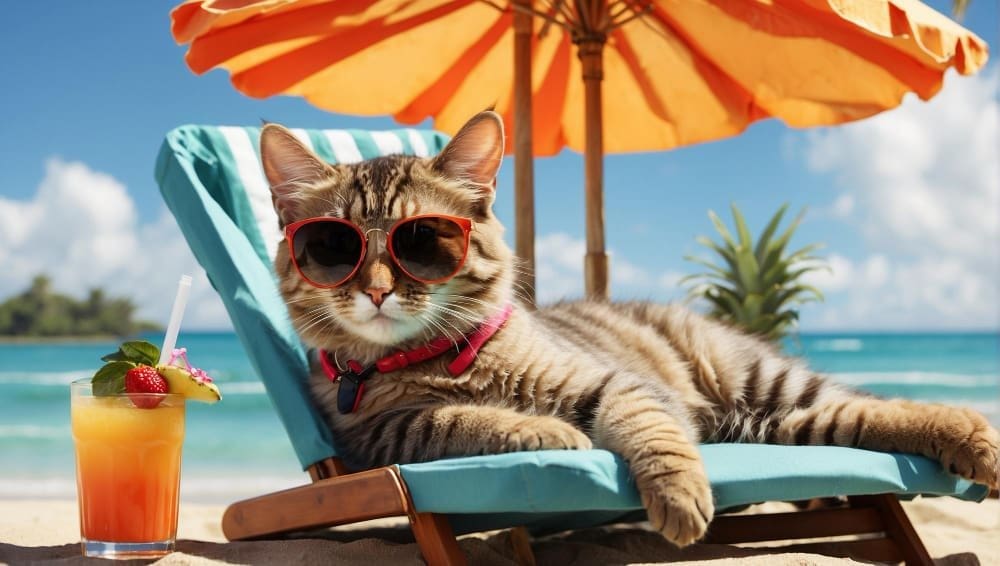As the summer months approach, it is important to ensure that your furry feline companion stays cool and comfortable amidst the rising temperatures. With a few simple measures, you can safeguard your cat from the potential dangers of overheating. From providing plenty of fresh water and shade to monitoring exercise during the hottest parts of the day, this article will guide you on how to protect your beloved pet from the scorching heat of summer.
Providing Adequate Shelter
Indoor Retreats
During the summer months, it is essential to provide your feline companion with a cool indoor retreat. Cats are very susceptible to heatstroke, so ensuring they have a comfortable space to escape the heat is crucial. Set up a designated area for your cat that is shaded and well-ventilated. This can be a small room with a fan or air conditioning, or even a cozy corner with a comfortable bed and access to fresh water.
Outdoor Shelters
If your cat enjoys spending time outdoors, it is important to provide them with a suitable outdoor shelter. This can be a covered patio, a specially designed cat enclosure, or even a cat-sized tent. Make sure the shelter is well-ventilated and has access to shade throughout the day. Provide a comfortable bed or mat for your cat to relax on, and always ensure there is fresh water available.
Ensuring Hydration
Fresh Water Availability
Proper hydration is crucial for cats, especially during the hot summer months. Make sure your cat always has access to fresh, clean water. Keep multiple water bowls throughout your home, especially in areas where your cat spends a lot of time. Check the water bowls regularly and refill them as needed to ensure your cat always has access to fresh water.
Use of Water Bowls and Fountains
Consider using a cat water fountain to encourage your feline friend to drink more. Cats are often attracted to running or flowing water, and a water fountain can help keep their water supply fresh and appealing. Additionally, some cats may prefer drinking from a moving water source rather than a still bowl. Experiment with different types of water bowls and fountains to find what works best for your cat.
Managing Temperature
Use of Air Conditioning
Air conditioning can be a lifesaver for your cat during the hot summer months. If you have central air conditioning, make sure to keep your home at a comfortable temperature for your feline friend. If you don’t have central air, consider using portable air conditioners or fans to cool specific areas of your home. Your cat will appreciate the relief from the heat and be able to retreat to a cool space whenever needed.
Creating a Cool Environment
In addition to air conditioning, there are other ways you can create a cool environment for your cat. Keep blinds or curtains closed during the hottest parts of the day to block out the sun’s rays. Provide your cat with cool surfaces to lay on, such as marble or ceramic tiles. You can also place ice packs or frozen water bottles wrapped in a towel near your cat’s favorite resting spots for additional cooling relief.
Protecting from Sunburn
Limiting Exposure to Sun
Just like humans, cats can also get sunburned. To prevent sunburn, it is important to limit your cat’s exposure to the sun, especially during the peak hours of the day. Keep your cat indoors or provide them with a shaded outdoor area where they can stay protected from the sun’s harmful rays. Remember, cats with lighter fur or thin coats are more susceptible to sunburn, so take extra precautions with these cats.
Applying Pet-Friendly Sunscreen
If your cat will be spending time outdoors and cannot avoid sun exposure, consider applying a pet-friendly sunscreen. A sunscreen specifically formulated for cats or babies can help protect their sensitive skin from harmful UV rays. Consult with your veterinarian to find a suitable sunscreen and get guidance on how to safely apply it to your cat.
Maintaining Grooming
Brushing for Shedding Control
Regular grooming during the summer months is important to keep your cat’s coat healthy and prevent matting. Brush your cat regularly to remove any loose hair and reduce shedding. This will help keep your cat cool by preventing their fur from becoming matted and trapping heat. Choose a grooming brush that is suitable for your cat’s coat length and texture, and make grooming sessions a positive and bonding experience for both of you.
Removing Mats and Tangles
If your cat does develop mats or tangles in their fur, it’s important to address them promptly. Mats can trap heat and cause discomfort for your cat. Use a detangling spray or a comb specifically designed to remove mats and gently work through any tangles. If the mats are too severe or sensitive areas are involved, consult with a professional groomer or your veterinarian for assistance.
Providing Proper Ventilation
Avoiding Hot Cars
Never leave your cat alone in a parked car during the summer months. Cars can heat up quickly and become life-threatening for your cat within minutes, even with the windows cracked open. If you need to transport your cat in the car, make sure the air conditioning is on, and keep the car cool before placing your cat inside. Also, be mindful of the pavement temperature when walking your cat outside. Hot pavement can burn their paws, so try to avoid walking on hot surfaces during peak heat hours.
Circulating Air in the Home
Proper ventilation is crucial to maintain a comfortable environment for your cat. Make sure air can circulate freely throughout your home by keeping doors and windows open, using fans, or using air purifiers. This will help remove stale air and keep your cat cool and comfortable. Remember to also remove any potential obstacles that may block the airflow, ensuring the entire space remains well-ventilated.
Ensuring Paw Protection
Avoiding Hot Surfaces
During the summer months, hot surfaces such as asphalt, sand, or metal can become scorching hot and cause burns to your cat’s paws. When taking your cat outside, avoid walking them on these surfaces. Stick to shaded areas or grassy surfaces to protect their sensitive paws from burns or discomfort. If you’re unsure if a surface is safe, test it with your hand first. If it’s too hot for your hand, it’s too hot for your cat’s paws.
Using Protective Paw Balms
To provide an extra layer of protection for your cat’s paws, consider using a protective paw balm. Paw balms are specially formulated to moisturize and create a barrier between your cat’s paws and hot surfaces. Apply the paw balm before going outside to help prevent burns or cracking caused by the heat. Make sure to choose a pet-safe paw balm and follow the manufacturer’s instructions for application.
Preventing Dehydration
Signs of Dehydration
Dehydration can be a serious health concern for cats, especially during the summer when they are more prone to losing fluids through panting and sweating. It is crucial to be aware of the signs of dehydration in your cat, which include dry gums, excessive panting, lethargy, and loss of appetite. If you notice any of these symptoms, contact your veterinarian immediately.
Encouraging Drinking
To prevent dehydration, encourage your cat to drink plenty of water. Ensure fresh water is readily available in multiple locations throughout your home and refresh it regularly. Some cats may prefer running water, so consider using a water fountain as mentioned earlier. Additionally, you can try adding ice cubes to your cat’s water bowl to make it more enticing and refreshing.
Monitoring Overall Health
Recognizing Heatstroke Symptoms
Heatstroke is a serious condition that can be life-threatening for cats. It is essential to recognize the symptoms of heatstroke and act promptly if you suspect your cat is suffering from it. Some common signs of heatstroke include rapid breathing, excessive panting, vomiting, drooling, and lethargy. If your cat shows any of these symptoms, move them to a cool, shaded area immediately and contact your veterinarian for further guidance.
Regular Veterinary Check-ups
Routine veterinary check-ups are important for monitoring your cat’s overall health, especially during the summer months when they are more susceptible to heat-related illnesses. Regular check-ups allow your veterinarian to assess your cat’s condition, provide preventive care, and address any concerns promptly. They can also provide guidance specific to your cat’s needs, ensuring they stay healthy and safe during the summer.
Minimizing Stress
Reducing Outdoor Activities
Extreme heat can be stressful for cats, so it’s important to minimize their outdoor activities during the hottest parts of the day. Instead, engage in playtime or interactive toys indoors. Create a stimulating environment with scratching posts, tunnels, and toys to keep your cat mentally and physically active. By reducing the amount of time your cat spends outdoors during peak heat, you can help prevent them from becoming overheated and stressed.
Providing Calm Indoor Spaces
Creating calm indoor spaces for your cat is essential to minimize stress during the summer months. Set up cozy corners with comfortable beds, blankets, or even a hammock for your cat to relax and retreat to. Use Feliway diffusers or calming sprays in these areas to create a peaceful atmosphere. Providing your cat with a serene environment can help them feel safe and secure, reducing stress levels and promoting overall well-being.
Protecting your feline companion from the summer heat is crucial for their well-being. By following these tips, you can ensure your cat stays cool, hydrated, and comfortable throughout the summer months. Remember to monitor their behavior closely and seek veterinary attention if you notice any signs of distress or heat-related illness. With proper care and attention, you can enjoy a safe and enjoyable summer with your beloved furry friend.


